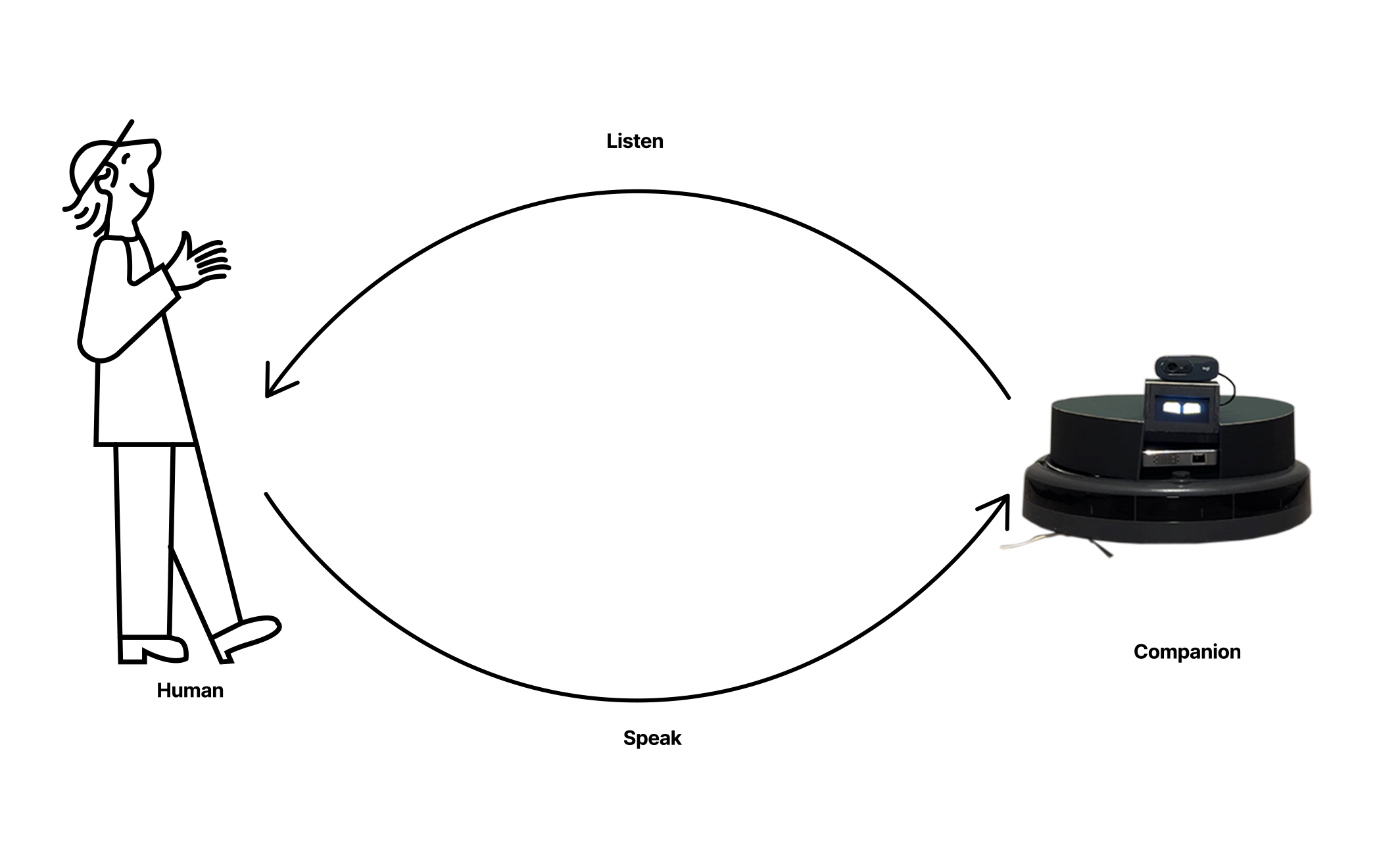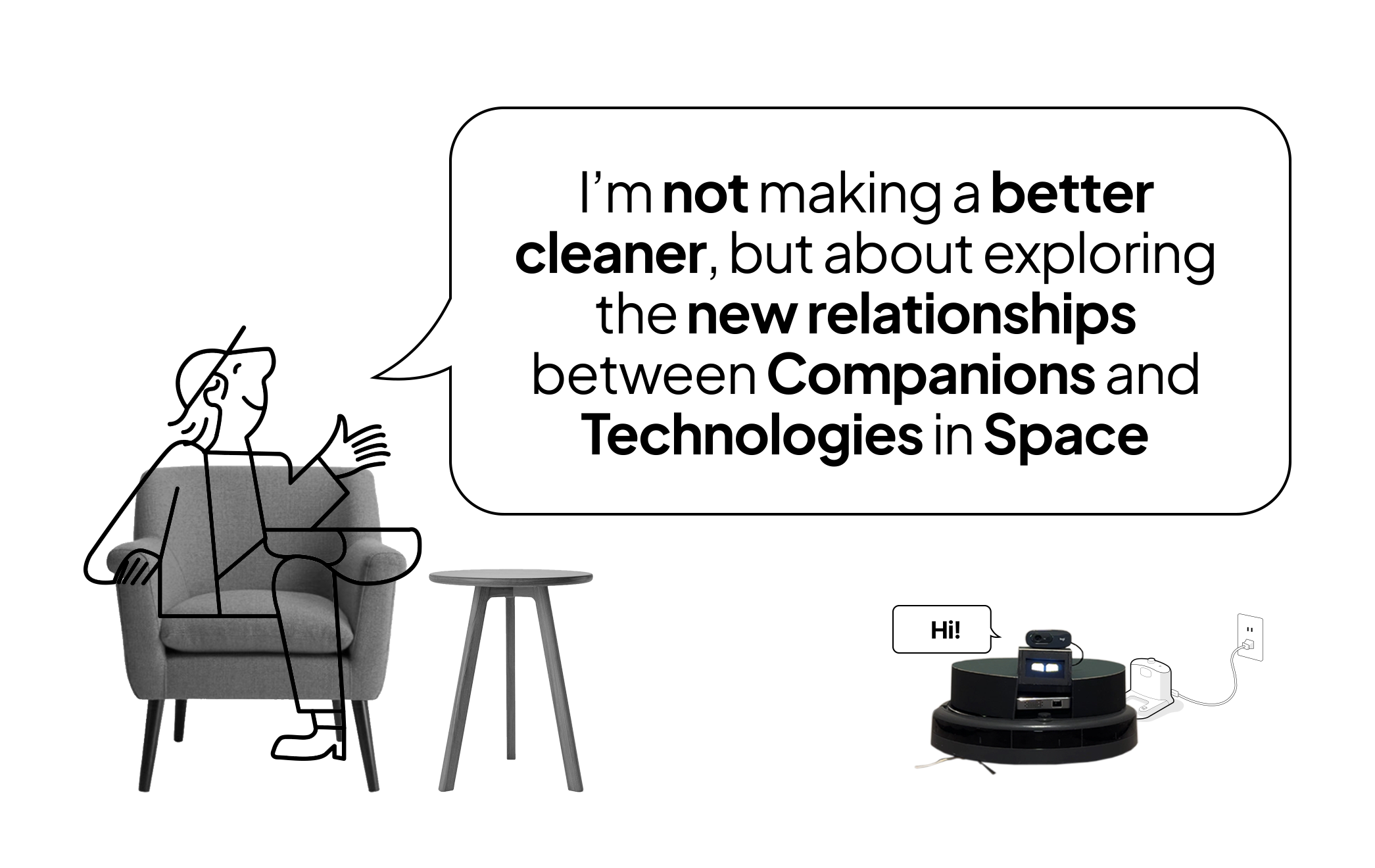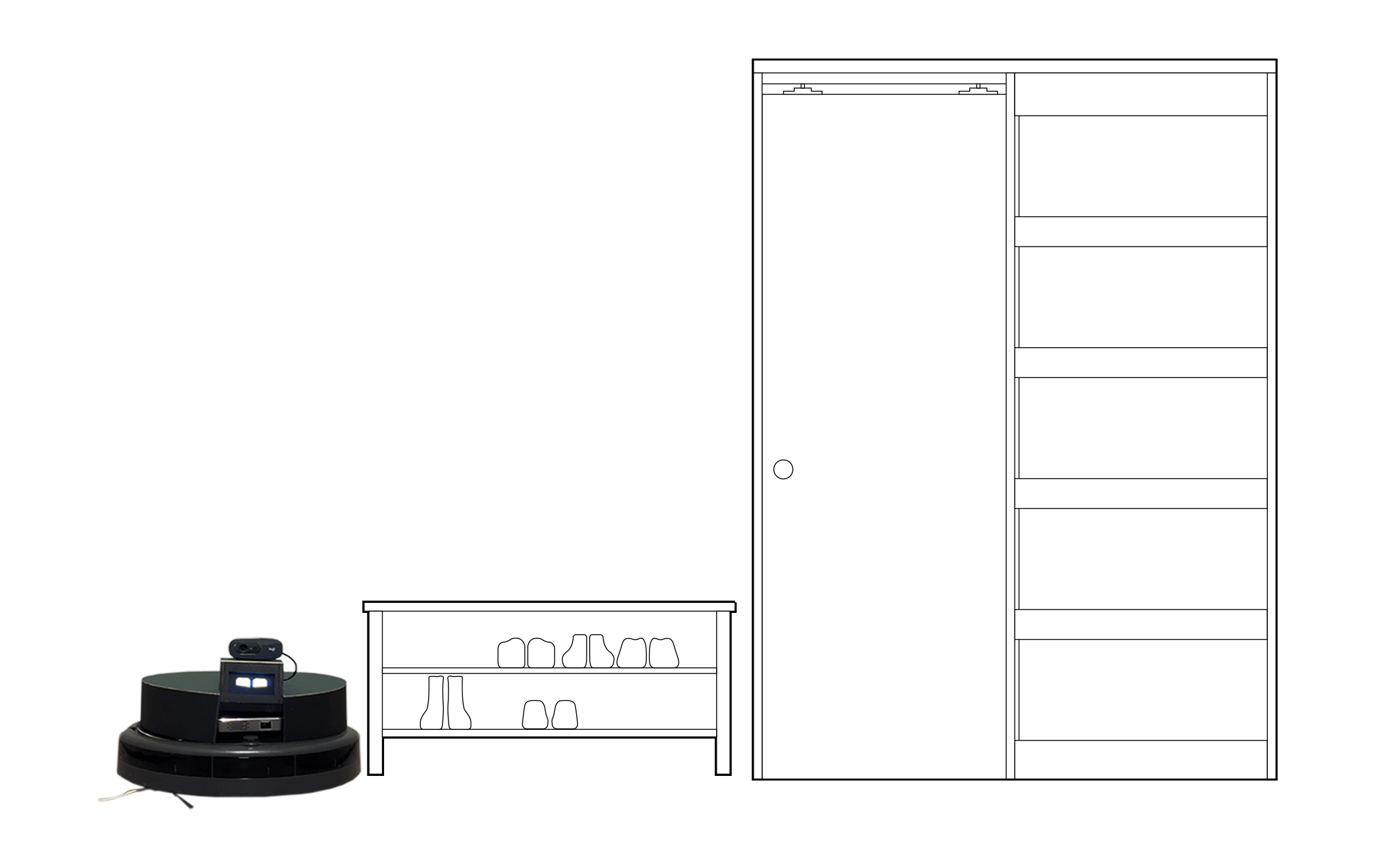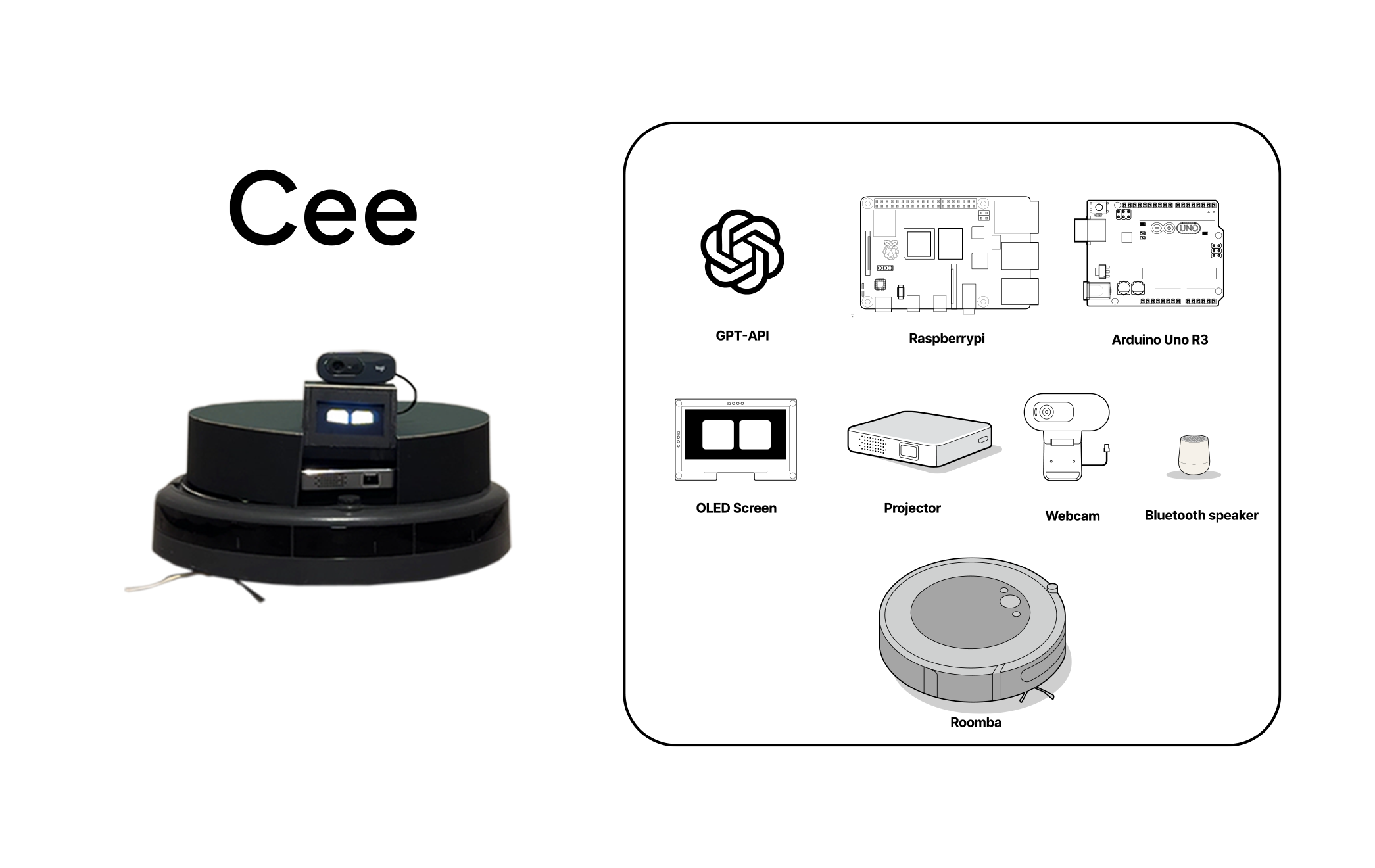Companion, Cohabitant and Continuum (Cee)
Pakjira Itthisang (Fern)

As a spatial designer, I started thinking about how robot vacuums behave at home. Mine bumps into my legs as if it's asking for attention, eats charger wires, brushes against dog tails, and gets stuck in tiny corners—almost like it's alive! [1][2]
These funny moments made me wonder: what if it's more than just a cleaner? Most robot vacuums simply tidy up, but our homes are full of feeling and culture. My capstone project asks:
"What if this companion could talk? What if it could express itself—not just beep when stuck, but actually communicate? Instead of just cleaning, could it feel more like a roommate, sharing the space with you?"
Project's Background
How it began - First Proporsal
In the fall semester, I began this project by researching how emotional interaction and spatial awareness could be applied to home robots—especially robot vacuums. I focused on how these machines might become more than just tools: how they could express themselves, adapt to environments, and respond to people in meaningful ways [3][4].
🧪 Design Approach
I divided this project into two main parts: design methods and technical methods, working together to explore how a robot can feel more like a companion than a machine. [5] [6]
1. Design Methods
"Experimental, Critical, and Speculative Design"
This part focused on imagining new ways to live with technology—not just solving problems, but asking new questions about everyday relationships with machines.
- Human-Centered Interaction
The robot responds to people—through sound, voice, gaze, or movement—creating emotional moments instead of just running in the background.
- Adaptive Navigation
Instead of randomly bumping around, the robot moves with intent. It knows when to come closer, when to pause, and how to act in shared space.
- Feedback Loop Design
The robot improves over time. It learns from your habits and responds to changes in the environment—just like a roommate adapting to your routine.
2. Technical Methods
"Adaptive, Emotional, and Culturally Aware Technology"
This part focused on building a system that could see, listen, feel, and respond—not just mechanically, but emotionally and culturally.
- Camera Vision
A webcam allows the robot to detect faces, people, shoes, and objects in its path.
- Machine Learning
The system can recognize emotional cues or cluttered areas and decide what behavior fits best.
- API Integration
Real-time data (like weather) is used to generate daily fortune-telling, GPT-based conversations, and personalized responses.
- Sensor Fusion
Combines data from sound, movement, and vision to help the robot act more naturally in the home.
📚 Key References and Examples
I looked at past projects that made technology feel alive, emotional, or cultural:
- Roomba 694 by iRobot: A functional cleaner with limited human interaction. [7]
- Tamagotchi by Bandai: A toy that builds emotional attachment through care.[8]
- Furby by Hasbro : A robot that learns and reacts to people with voice and movement.[9]
- Alexa & Siri: Helpful but impersonal voice assistants.[10] [11]
- Tweenbots by Kacie Kinzer: Small robots that depend on human kindness. [12]
- Objective Realities by Automato: A VR project exploring life as a smart object. [13]
- Twin Mirror by Danil Nagy: A mirror using machine learning to reflect alternate identities.[14]
- Robot Delivery in Japan (Uber Eats): Shows how robots are quietly entering everyday urban life.[15]
🔬 Research
I focused my research on four key areas:
💬 Research 1: Emotional Interaction
How machines can show feelings and moods using expression, sound by documenting different existing technologies.
🏠 Research 2: Spatial & Environmental Awareness
How robots can move through space with cultural awareness—not just logic.
🌏 Research 3: Cultural Context
This part of the research focused on how different cultures shape our emotional and symbolic relationships with space, rituals, and technology.
-Thailand
In Thai beliefs, everyday objects—especially those in the home—can carry spiritual energy. This inspired me to design the robot's movements to feel respectful, calm, and slow, especially in the Butler and Fortuneteller modes.
-Japan
Japanese spatial ideas like Ma (the space between things) and Wa (harmony) taught me to think about the emotional atmosphere of a room. I used this to shape the robot's eye expressions, voice, and movement style, making it feel like it belongs in the space, not just moves through it.
-Asian Fortune Culture
In many Asian cultures, fortune-telling is a popular daily ritual—especially in the morning or at the start of a new year. This inspired the Fortuneteller persona, which uses the user's birthdate and live weather data to offer light, thoughtful fortunes that add a small moment of wonder to the day.
-Western Technology Culture
In the West, tools like Alexa or Siri are focused on efficiency—but they often feel cold or distant. I wanted this project to go beyond function and bring warmth, empathy, and cultural meaning into everyday interaction.
Together, these cultural ideas helped me design a robot vaccums that feels more like a companion than a machine.
"As I combine global data (like weather) with personal data (like birthdate) to create a small, meaningful ritual each day. The goal is to give people something that feels personal, poetic, and alive—reminding us that technology can feel magical when it reflects both who we are and the world we live in."
🛠️ Prototypes
To test these ideas, I built two early prototypes:
🎞️ Prototype 1: Narrative & Interaction
This prototype tested how the robot might act like a companion in shared space. I focused on storytelling and how the robot could interact with people.
🤖 Prototype 2: Emotional and Interactive Prototype
This version tested how the robot could speak using GPT, express emotions, and deliver daily fortunes based on weather and birthdate. It included real-time interaction, emotional voice tone, and more complex sensing of the user.
Before the Big Step — Defining the Project's Direction
During winter break and the start of the spring semester, I began connecting my early observations and prototypes to broader ideas about culture, emotion, and space. At that point, I realized this project was never just about improving a cleaning tool—it was about redefining how we live with technology and how we build a new kind of relationship in space.
These five key ideas became the foundation of the final concept:
- Japanese spatial concepts like Ma (間) [16]
Ma means the space between things—the quiet pause, the intentional gap. It inspired me to design the robot's movements to respect space, not just avoid obstacles.
- Thai beliefs about spirits in household objects
In Thai culture, even ordinary things can hold meaning or energy. That made me imagine the robot as more than functional—its presence had to feel calm, intentional, and alive.
- Robotic emotional expression
From projects like LOVOT [17] and Qoobo [18], I learned how a machine can show life through small gestures—blinking eyes, warm sounds, and gentle movement. I used these ideas to shape Cee's emotional language.
- The sociology of domestic labor
Cleaning is not just a task—it's often emotional, gendered, and invisible. I didn't want to erase that labor. I wanted to share it, to design a robot that could support care without taking it away.
- Ambient interaction design
Inspired by subtle and silent communication, I designed Cee to express emotions through glanceable gestures—eye gaze, body posture, and tone—without disrupting the flow of daily life.
"From those research I found"
"Relationships are what make a house feel like home."

What Is This Project Really About?
Companion, Cohabitant and Continuum, or Cee, is about the relationship in space through the integration of technological innovation with emotional intelligence to redefine the role of robot vacuums in the home.

Why the robot vacuum? Why not my washer or dryer?
For me, the robot vacuum is a model of life because:
- It moves and adapts, unlike others.
- It shares space with us while cleaning.
- It already looks alive—it follows routines and even gets "stuck" like a living creature.
And most importantly—it has a sense of humor, as seen in internet memes. It's already a character in our homes, and I wanted to explore that further."


Beyond Clean, there is Culture
Cleaning is not just a practical task—it holds meaning shaped by culture and daily life.
Across different cultures, the way we use space, arrange objects, and care for our surroundings reflects deeper values. In some places, cleaning is a spiritual act. In others, it's part of hospitality or a way to reset the day.
The state of a room can even be someone's first impression of how you live. A tidy home might say you're calm, organized, or welcoming. A messy space might suggest stress or busyness.
What we choose to clean—and what we leave untouched—can quietly tell the story of who we are.

Clean spaces contribute to mental well-being
There's a strong link between a clean space and a clear mind.[19]
Many traditions believe that tidiness brings good fortune, harmony, and emotional balance.
But when life feels overwhelming—when we're tired, stressed, or low on energy—cleaning often becomes the last thing we want to do. The mess piles up, and the space around us starts to mirror how we feel inside.
That's why cleanliness isn't just about appearances. It's about care, energy, and the small rituals that help us feel better, even on difficult days.

What is Cee appoarch?
"This is not just a device. This is a living companion who shares your space."
Cee is imagined not as a friend, a pet, or a simple tool—but as a new kind of cohabitant.
-It exists in your space, moves through it, and interacts with you daily. It's not something you own or play with. It's something you live with.
-In this part of the project, I focused on defining what kind of relationship this is.
-It's not a friend, because you don't command your friends. They have their own will and boundaries.
-It's not a pet, because we often can't fully understand what pets are thinking—and they don't always do what we ask.
-It's not just a tool, because it's aware, expressive, and capable of emotional interaction.
Instead, this cohabitant sits in a new category: One that listens, responds, and understands. One that you can speak to clearly, ask for help, and share your space with—while it responds in kind, not just by cleaning, but by communicating, sensing, and performing presence.
This approach opens up a new kind of living relationship—one where emotional intelligence and spatial awareness define how we coexist with this companion.

Who is Cee will be?
It's Not One Cohabaitant but It's Four Personas
At first, I experimented with characters based on different types of users: The Minimalist, The Social Host, The Remote Worker, The Child, and The Elderly. Each version had its own voice tone and speed, adapted to different lifestyles.
🎞️ First Prototype: experimented with characters
This prototype tested how the robot might act like a companion in shared space. I focused on storytelling and how the robot could interact with people.
But through testing, I realized something important: These weren't cohabitants. They felt more like service modes—helpers, not companions. They responded to tasks, but didn't feel emotionally or spatially present.
So I asked myself a new set of questions:
-1. What is the quality of being I want this companion to have? and What role should it play in the home?
-2. What behaviors should it repeat or learn over time?
-3. What actions should it take—on its own or in response to us?
-4. What sensors, tools, or data should it use to make these decisions?

That's when the idea of four core personas emerged—each one designed to reflect a different kind of shared life with the companion.
-🤵♂️ The Butler
The Butler welcomes people with grace and calm.
It observes, opens space, and maintains order in subtle ways—reminding us to remove our shoes, greeting guests, and making the home feel cared for.
-🔮 The Fortuneteller
The Fortuneteller brings joy through daily rituals.
It uses personal and environmental data—like your birthdate and the weather—to deliver small moments of wonder, surprise, or reflection.
-🛋️ The Therapist
The Therapist listens silently and responds gently.
It notices how you're feeling through tone, posture, or silence—and offers soft, non-intrusive companionship.
It doesn't try to fix you—it simply stays with you.
-🧼 The Cleaner
The Cleaner maintains the environment quietly and respectfully.
It works in the background, not asking for attention but keeping the space in balance—honoring the act of care without demanding thanks.
Each persona has its own behavior loop, voice tone, emotional expressions, and way of interacting with the room.Together, they form a new kind of cohabitant—not just helpful, but present. Not just reactive, but expressive. Not just in your space—but part of it.

Designing Personality Through FSM To bring these questions into a working system, I designed a Finite State Machine (FSM) to define Cee's behavior. Each persona—Butler, Fortuneteller, Therapist, Cleaner—is built as a state within the FSM, with:
-Specific triggers (e.g., presence detection, time of day, emotion recognition)
-Defined responses (movements, spoken dialogue, eye animations)
-Unique voice tone and emotional expressions
-The ability to transition to another state based on user interaction or environmental cues
This structure allowed me to choreograph how Cee "performs" presence—not just through automation, but through meaningful transitions that mirror social behavior.

How Cee works?
"It's not just reactive. It performs."
Cee is built to sense, respond, and express—not like a machine, but like a cohabitant with presence and mood.
It does this by combining hardware, software, and design into one expressive system:
- 🧠 The Brain is GPT
It generates thoughtful responses, emotional language, and spoken interactions using OpenAI's language model.
- 👀 The Eyes are OLED Screens
Two animated displays show shifting emotions—through blinking, glancing, and expressive shapes that mirror mood.
- 🗣️ The Voice Speaks Through a Speaker
Each persona has a different tone and speed. It doesn't just say words—it communicates feeling through sound.
- ⚙️ The Body is a Hacked Roomba
It moves gently and intentionally, adapting to room conditions and responding to presence.
- 👁️🗨️ It Sees You With a Webcam
The camera detects people, faces, shoes, and objects. It knows when someone enters, when someone lingers, or when the room is empty.
- 🎯 It Matches Emotion With Action
It recognizes emotional cues, detects clutter, and selects a suitable expression—blinking happily, looking curious, or pausing silently.
This is not automation—it's performance. Each movement, glance, and phrase is part of a small choreography between you and the machine. A language of space, feeling, and cohabitation.

Demo: A Day with the Cee
After months of research, prototyping, and testing, the final demo shows how this robotic cohabitant moves, reacts, and expresses itself through the four personas.
This is not just a performance of function—it's a performance of presence. Each persona has its own way of sensing the space and responding:
- The Butler: greets people, offers gentle reminders, and invites care into the room.
- The Fortuneteller: uses the day's weather and your birthdate to share thoughtful fortunes.
- The Therapist: offers soft emotional support—responding with eye movements, voice tone, and stillness.
- The Cleaner: quietly restores order, reading the room's energy and acting with subtle awareness.
The demo includes:
- Real-time emotion recognition through a webcam
- GPT-generated spoken dialogue
- OLED eye animations based on mood
- Context-based behaviors driven by user presence and environment
\
"This is not just a device—it's a living companion who shares your space.
Because in the end, relationships are what make a house feel like home."
Because in the end, relationships are what make a house feel like home."
"This is not just a device—it's a living companion who shares your space.
Because in the end, relationships are what make a house feel like home."
Because in the end, relationships are what make a house feel like home."
- Friend.com Mobile Media USC
- Browser-Controlled Roomba Robot With the Raspberry Pi
- "AI ChatGPT Boyfriend Companion"
- Bloomberg News Article
- Reddit Futurology Discussion
"Your Roomba may be vacuuming up more than you think", The New York Times ↩︎
"Roomba vacuum maker iRobot betting big on the 'smart' home", Reuters ↩︎
Anthony Dunne & Fiona Raby, Speculative Everything ↩︎
Matt Malpass, Critical Design in Context ↩︎
John Ferrara, Playful Design ↩︎
Miguel Sicart, Play Matter ↩︎
"The Japanese words for space could change your view of the world" ↩︎